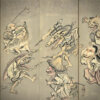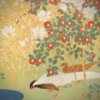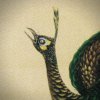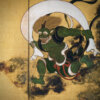Noguchi Shōhin: Representative Modern Female Naga Painter
Fuyō Natsugamo ( Confederate Roses and Spot‐Billed Duck)
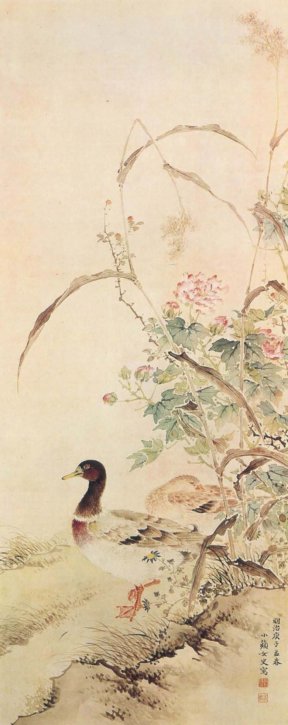
Noguchi Shōhin was born in Osaka in 1847. She loved painting since she was a child and traveled to the Hokuriku Tokai region with her parents, but she lost his father at the age of 16 and later went to Kyōto to become a disciple of Hine Taizan in 1867. It is said that she worked hard to learn the painting, and was good at Kachō-ga (painting of birds and flowers) and Sansui-ga (landscape painting). At the age of 24, Shōhin, who lost his mother and had no family, moved to Tōkyo in 1871. In 1873, he drew Kakiya-zu (flower painting) on the shoji (sliding paper door) and byōbu (folding screen) of the imperial palace’s bedroom and became famous. In 1877, she married Noguchi Masaaki and moved to Shiga Prefecture, but in 1882 she returned to Tōkyo and lived there permanently. She received the Bronze Award at the Tōyō Kaiga Kyōshinkai exhibition in 1886, and after the establishment of the Nihon Bijutsu Kyōkai, she was active mainly in the exhibition of the association, and in 1901 she received a gold medal. Besides, she was appointed as a part-time professor at the Kazoku Jogakko in 1889. Since she made many paintings for the government and frequently taught the imperial family the painting, she had a deep relationship with the imperial family and became the first woman Teishitsu Gigei-in (government’s artist) in 1904. In 1915, she produced a byōbu painting for the throne of Emperor Taishō. She was the head of the Meiji period Nanga painting world together with Okuhara Seiko, and while inheriting the techniques of her teacher Taizan, she had a feminine, warm and elegant character, and shows a solemn and detailed style that contrasts with Seiko’s lavishness. She died in 1917 at the age of 71 years old, and she had a Nanga painter Noguchi Shōkei as her oldest daughter.
This work was made in 1900 when Shōhin was at her best. She drew a pair of mallards resting on the edge of the water, carrizo, fuyō, wild chrysanthemum, and dead wild roses that had fruit born. All of them are drawn in detail with soft brush strokes and modest coloring, and a gentle autumn atmosphere is created. You can see Shōhin’s style with a fusion of sketching and Shai (expressing the painter’s heart or the nature of the object in Eastern-style paintings) in flowers and grasses which Shōhin was good at the most, such as the chrysanthemums that bloomed adorably beside fuyō, the broken carrizo with its ears hanging, or the vines of wild roses that entwined with those, etc.
Peonies, Cranes and Japanese Emperor Oak / Chrysanthemum, Chicken and Pine
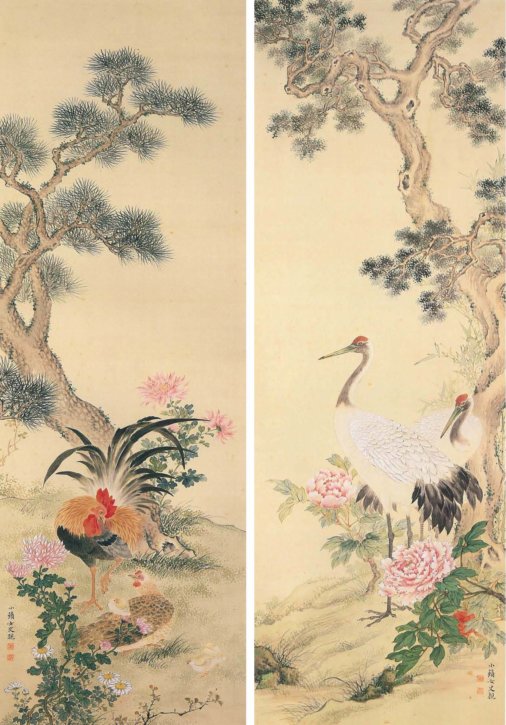
Noguchi Shōhin was a head Meiji period painter who often was treated in contrast to Okuhara Seiko. An art critic Umezawa Waken said, ” Seiko is single, and Shōhin has a husband, Seiko is unrelenting, the Shōhin is obedient, Seiko is living in the countryside secretly, and the other is an imperial artist. It is the distinctiveness of the Meiji period Nanga world that both of them are opposed to each other.” It is said that Seiko had a men’s hairstyle and dressed like a man, and had legendary episodes that no men have, but Shōhin kept being a good wife and wise mother. However, she also working hard on painting, and the recollection of his eldest daughter, Noguchi Shōkei, tells an anecdote that Shōhin promised to draw a thousand Seki-ga in a day and night when he was young, and kept that promise. Such a personality is clearly shown in Shōhin’s paintings. The work of Okuhara Seiko refuses to distinguish it from the work of a male painter. Shōhin’s delicate brush strokes and the soft and warm atmosphere are certainly feminine features.
This work is a pair of hanging scroll works that show the spring view depicting cranes and Japanese emperor oak, peony, etc., and the autumn view with a chicken and pine trees, various chrysanthemums, and dead wild roses. It depicts the world of flowers and birds with full of emotion using strict and meticulous techniques but without hardening. Especially, you can feel a rich emotional feeling in the chicken family depicted in the work on the left. Chrysanthemums and peonies beautifully depict the ecology of flowers from buds to full bloom. As with other works by Noguchi Shōhin, she drew chrysanthemums and peony into three flowers, which are buds, flowers beginning to bloom, and flowers in full bloom. Being more than being faithful to the basics, she breathed life into the flowers and adds time to the work. You can feel the detailed consideration of Noguchi Shōhin towards her work.

